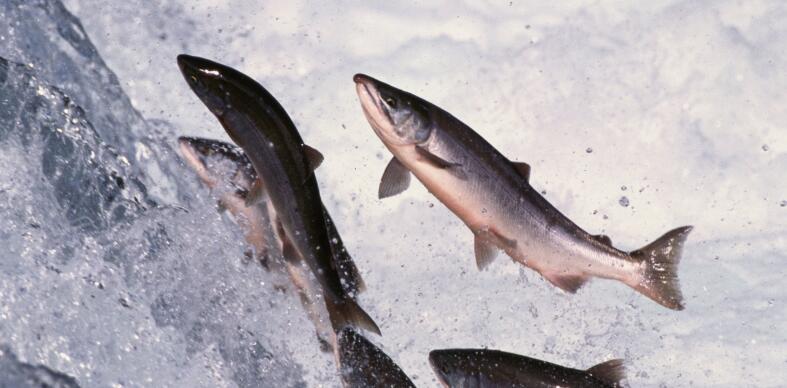The other day, we went to Adams River in British Columbia, Canada, to feel the shock of the migration of sockeye salmon. It’s a remarkable, impressive, and inspiring intellectual journey, in fact, the sight there can not be termed as enjoyable because in front of our faces, thousands of lives were fading away. The moment I got out of the car, I immediately noticed a billboard titled “salute salmon” but due to the large crowds around the river bank I had no chance to get closer and read it carefully.
The first time we went to Adams River, it was to simply satisfy our curiosity, but once we were on the scene, a feeling of deep depression and shock mixed with panic filled our hearts, and the sadness for salmon’s tragic and heroic life, felt just like dark clouds gathering overhead.
Then we went across a little bridge, crowded with people. Led by their eyes, I looked down into the stream, it was really quite a sight:the water was rippling and singing, shallow but fast-flowing, thousands of salmons packed tightly together in this waterway, each one approximately 10Ibs(5kg). The mass of distinctive, red-hued bodies tried their best to swim upstream. The salmon were not only swimming, they were climbing, jumping, and rushing over each other. The fish were exhausted after completing a 4,000km round trip. An arduous upstream swim through swift currents and rapids for 17 days seemed a huge effort to exert just to reach the spawning grounds where they laid their eggs and then died shortly thereafter.
Amidst the millions of salmon bodies within the tributary were many injuries, some bodies broken, bleeding and some salmon already dead. We were told that the fish were possibly injured due to the aggressive males fighting for the rights to spawn with the females or cut by rocks as the hurtled themselves upstream. After the females finished laying their eggs and the males fertilized them, both would pass away.
Salmon are a miraculous species, living a moving and heroic life. Their entire lifespan is dedicated towards one specific goal – a return trip to their spawning grounds. There are many elements and behaviors of salmon that still remain unknown to researchers.
The incredible journey of the sockeye salmon begins and ends in the Adams River. The salmon grow from eggs in fresh water streams of Adams River, through to the South Thompson River, then the Fraser River and into the Strait of Georgia of the Pacific Ocean. They spend 3 years of their lives swimming in the open water, along the Arctic Ocean, through to Alaska and the Aleutian Islands. Then they return on a 4,000km trip to their birthplaces to breed where they lay eggs and die. The new generation of salmon then begin the same 4-year cycle.
During October 1999, the quiet banks of Adams River became a turbulent scene of crimson. According to annual studies and counts researchers saw an estimated 10,000 plus salmon fighting to travel upstream to complete their lives’ journey. The long voyage needs not only strength but also courage, as during this journey courage, as during this journey the salmon do not eat, instead relying on the fat reserves they store up from feeding along the Strait of Georgia in the summer prior to traveling upstream. According to the experts, it is instinctive for the salmon to travel back to their natal river, and a highly developed olfactory system is also said to play a large part in this process. They use their amazing sense of smell to track their own scent trail, left on their first trip. When it is time to return to spawn, the trail leads them directly home. How mysterious they are!
The sockeye salmon will lay their eggs within the colorful days of fall, between September and October. During this time their bodies turn into their distinctive red-hue, while the males develop humped backs and aggressive hook mouths. During spawning he female salmon lies on one side and using her fin, digs a hole in the sand to lay her eggs, while a singular or several males swim around and fertilize the eggs. To cover and conceal her new fertilized eggs from potential predators, the female again utilizes her fin, with her last amount of strength.
After all this, their life cycle is accomplished, and within half a month, the salmons die. Their bodies are again a part of the natural process, eaten by other animals, torn apart by the waters, or used as sustenance by their progeny. It reminds me of the words of a poem by Gong Ding’an, a famous Chinese poet from the Qing Dynasty. The poem declares, “Things are dying, but love will remain.”























